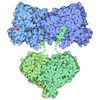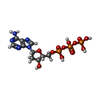+ Open data
Open data
- Basic information
Basic information
| Entry | Database: PDB / ID: 4v4l | |||||||||
|---|---|---|---|---|---|---|---|---|---|---|
| Title | Structure of the Drosophila apoptosome | |||||||||
 Components Components | Apaf-1 related killer DARK | |||||||||
 Keywords Keywords | APOPTOSIS / Drosophila apoptosome / programmed cell death | |||||||||
| Function / homology |  Function and homology information Function and homology informationnegative regulation of humoral immune response / positive regulation of glial cell apoptotic process / Formation of apoptosome / salivary gland histolysis / melanization defense response / sarcosine catabolic process / Activation of caspases through apoptosome-mediated cleavage / Regulation of the apoptosome activity / compound eye retinal cell programmed cell death / central nervous system formation ...negative regulation of humoral immune response / positive regulation of glial cell apoptotic process / Formation of apoptosome / salivary gland histolysis / melanization defense response / sarcosine catabolic process / Activation of caspases through apoptosome-mediated cleavage / Regulation of the apoptosome activity / compound eye retinal cell programmed cell death / central nervous system formation / positive regulation of apoptotic process involved in development / chaeta development / sperm individualization / apoptosome / autophagic cell death / Neutrophil degranulation / S-adenosylmethionine cycle / CARD domain binding / programmed cell death / triglyceride homeostasis / response to starvation / dendrite morphogenesis / response to gamma radiation / neuron cellular homeostasis / ADP binding / apoptotic process / structural molecule activity / ATP binding / identical protein binding Similarity search - Function | |||||||||
| Biological species |  | |||||||||
| Method | ELECTRON MICROSCOPY / single particle reconstruction / cryo EM / Resolution: 6.9 Å | |||||||||
 Authors Authors | Yuan, S. / Topf, M. / Akey, C.W. / Ludtke, S.J. | |||||||||
 Citation Citation |  Journal: Structure / Year: 2011 Journal: Structure / Year: 2011Title: Structure of the Drosophila apoptosome at 6.9 å resolution. Authors: Shujun Yuan / Xinchao Yu / Maya Topf / Loretta Dorstyn / Sharad Kumar / Steven J Ludtke / Christopher W Akey /  Abstract: The Drosophila Apaf-1 related killer forms an apoptosome in the intrinsic cell death pathway. In this study we show that Dark forms a single ring when initiator procaspases are bound. This Dark-Dronc ...The Drosophila Apaf-1 related killer forms an apoptosome in the intrinsic cell death pathway. In this study we show that Dark forms a single ring when initiator procaspases are bound. This Dark-Dronc complex cleaves DrICE efficiently; hence, a single ring represents the Drosophila apoptosome. We then determined the 3D structure of a double ring at ∼6.9 Å resolution and created a model of the apoptosome. Subunit interactions in the Dark complex are similar to those in Apaf-1 and CED-4 apoptosomes, but there are significant differences. In particular, Dark has "lost" a loop in the nucleotide-binding pocket, which opens a path for possible dATP exchange in the apoptosome. In addition, caspase recruitment domains (CARDs) form a crown on the central hub of the Dark apoptosome. This CARD geometry suggests that conformational changes will be required to form active Dark-Dronc complexes. When taken together, these data provide insights into apoptosome structure, function, and evolution. | |||||||||
| History |
|
- Structure visualization
Structure visualization
| Movie |
 Movie viewer Movie viewer |
|---|---|
| Structure viewer | Molecule:  Molmil Molmil Jmol/JSmol Jmol/JSmol |
- Downloads & links
Downloads & links
- Download
Download
| PDBx/mmCIF format |  4v4l.cif.gz 4v4l.cif.gz | 2.7 MB | Display |  PDBx/mmCIF format PDBx/mmCIF format |
|---|---|---|---|---|
| PDB format |  pdb4v4l.ent.gz pdb4v4l.ent.gz | Display |  PDB format PDB format | |
| PDBx/mmJSON format |  4v4l.json.gz 4v4l.json.gz | Tree view |  PDBx/mmJSON format PDBx/mmJSON format | |
| Others |  Other downloads Other downloads |
-Validation report
| Arichive directory |  https://data.pdbj.org/pub/pdb/validation_reports/v4/4v4l https://data.pdbj.org/pub/pdb/validation_reports/v4/4v4l ftp://data.pdbj.org/pub/pdb/validation_reports/v4/4v4l ftp://data.pdbj.org/pub/pdb/validation_reports/v4/4v4l | HTTPS FTP |
|---|
-Related structure data
| Related structure data |  5235MC M: map data used to model this data C: citing same article ( |
|---|---|
| Similar structure data |
- Links
Links
- Assembly
Assembly
| Deposited unit | 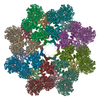
|
|---|---|
| 1 |
|
| Symmetry | Point symmetry: (Schoenflies symbol: D8 (2x8 fold dihedral)) |
- Components
Components
| #1: Protein | Mass: 123195.531 Da / Num. of mol.: 16 Source method: isolated from a genetically manipulated source Source: (gene. exp.)   #2: Chemical | ChemComp-MG / #3: Chemical | ChemComp-DTP / Sequence details | AUTHORS STATE THAT THE ACTUAL SEQUENCE FOR THE PROTEIN IS: ...AUTHORS STATE THAT THE ACTUAL SEQUENCE FOR THE PROTEIN IS: MDFETGEHQY | |
|---|
-Experimental details
-Experiment
| Experiment | Method: ELECTRON MICROSCOPY |
|---|---|
| EM experiment | Aggregation state: PARTICLE / 3D reconstruction method: single particle reconstruction |
- Sample preparation
Sample preparation
| Component |
| |||||||||||||||
|---|---|---|---|---|---|---|---|---|---|---|---|---|---|---|---|---|
| Molecular weight | Value: 2.5 MDa / Experimental value: NO | |||||||||||||||
| Buffer solution | Name: HEPES buffer / pH: 7.5 Details: 20mM HEPES, 10mM KCl, 1.5mM MgCl2, 1mM EDTA, 1mM EGTA, 1mM DTT | |||||||||||||||
| Specimen | Conc.: 2 mg/ml / Embedding applied: NO / Shadowing applied: NO / Staining applied: NO / Vitrification applied: YES Details: 20mM HEPES, 10mM KCl, 1.5mM MgCl2, 1mM EDTA, 1mM EGTA, 1mM DTT | |||||||||||||||
| Specimen support | Details: C-flat 2/1 holey grids (400 mesh) covered with a thin carbon film | |||||||||||||||
| Vitrification | Instrument: FEI VITROBOT MARK III / Cryogen name: ETHANE / Temp: 77 K / Humidity: 100 % Details: blotting at room temperature with sample at room temperature Method: Blot for 2-2.5s before plunging |
- Electron microscopy imaging
Electron microscopy imaging
| Experimental equipment |  Model: Tecnai F20 / Image courtesy: FEI Company |
|---|---|
| Microscopy | Model: FEI TECNAI F20 / Date: Sep 15, 2009 Details: actual magnification at the ccd 87000, camera pixel size 15um, 1.72 angstrom per pixel, data collected semi-automatically with EMTools (TVIPS) |
| Electron gun | Electron source:  FIELD EMISSION GUN / Accelerating voltage: 160 kV / Illumination mode: FLOOD BEAM FIELD EMISSION GUN / Accelerating voltage: 160 kV / Illumination mode: FLOOD BEAM |
| Electron lens | Mode: BRIGHT FIELD / Nominal magnification: 50000 X / Calibrated magnification: 50000 X / Nominal defocus max: 3000 nm / Nominal defocus min: 1500 nm / Cs: 2 mm Astigmatism: objective lens astigmatism was corrected at 200,000 times magnification Camera length: 0 mm |
| Specimen holder | Specimen holder model: GATAN LIQUID NITROGEN Specimen holder type: Side entry liquid nitrogen-cooled cryo specimen holder Temperature: 93 K / Temperature (max): 100 K / Temperature (min): 93 K / Tilt angle max: 0 ° / Tilt angle min: 0 ° |
| Image recording | Electron dose: 20 e/Å2 / Film or detector model: GENERIC TVIPS (4k x 4k) |
| Radiation | Protocol: SINGLE WAVELENGTH / Monochromatic (M) / Laue (L): M / Scattering type: x-ray |
| Radiation wavelength | Relative weight: 1 |
- Processing
Processing
| EM software |
| ||||||||||||||||||||
|---|---|---|---|---|---|---|---|---|---|---|---|---|---|---|---|---|---|---|---|---|---|
| CTF correction | Details: each CCD frame | ||||||||||||||||||||
| Symmetry | Point symmetry: D8 (2x8 fold dihedral) | ||||||||||||||||||||
| 3D reconstruction | Method: projection matching / Resolution: 6.9 Å / Resolution method: FSC 0.5 CUT-OFF / Num. of particles: 48271 / Actual pixel size: 1.72 Å Details: Projection matching was done with Fourier ring correlation, model-based masking and SSNR weighting over an 80-6 angstrom resolution range. The final refinement steps used an angular step of ...Details: Projection matching was done with Fourier ring correlation, model-based masking and SSNR weighting over an 80-6 angstrom resolution range. The final refinement steps used an angular step of 2.5 degrees and each of the 48,000 particles was matched to the best two projection classes (1353). In total, 45,000 particles were used in the final reconstruction and the 3D map was amplitude corrected then Gaussian low-pass filtered with a Fourier half-width of 0.12. Num. of class averages: 1353 / Symmetry type: POINT | ||||||||||||||||||||
| Atomic model building | Protocol: FLEXIBLE FIT / Space: REAL / Target criteria: Cross-correlation coefficient Details: METHOD--Flexible fitting, local refinement REFINEMENT PROTOCOL--rigid body first, and then used individual helices DETAILS--Chimera was used to do initial domain fitting with Apaf-1 (1Z6T) ...Details: METHOD--Flexible fitting, local refinement REFINEMENT PROTOCOL--rigid body first, and then used individual helices DETAILS--Chimera was used to do initial domain fitting with Apaf-1 (1Z6T) and CED-4 (2A5Y)domains. Modeller and Flex-Em were then used to do local refinement of homology models of the various domains. | ||||||||||||||||||||
| Refinement step | Cycle: LAST
|
 Movie
Movie Controller
Controller



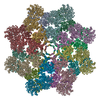
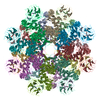
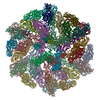
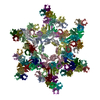
 PDBj
PDBj


